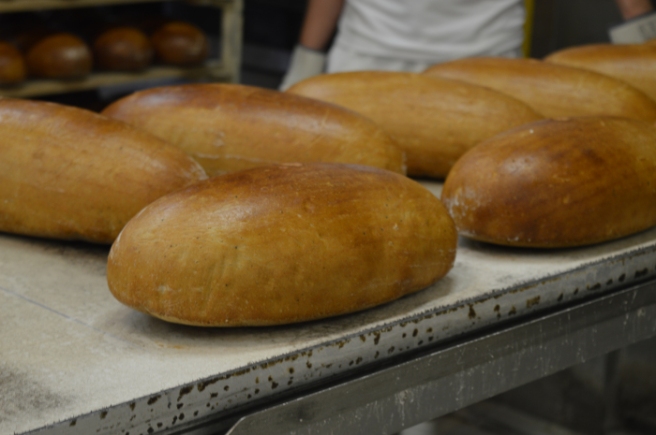Despite the latest trends and fashions, which have put this ingredient on the list of most evil enemies in our diets, Slovaks are not ready yet to have flour removed from their kitchens. Very few of them would think of replacing traditional wheat flour with gluten-free substitutes, unless gluten is a serious health issue.
We tend to think of flour (múka in Slovak) as powder milled from grains, especially wheat and rye, so anything like banana, rice or tapioca flour raises eyebrows and is looked upon with suspicion.
There are a few Slovak websites and food speciality shops that sell them, but they come at monstrous prices, because they have to be imported from far-away countries. Moreover, these gluten-free flours don’t produce the fluffy cakes or crusty breads we love so much.
Wheat and rye, on the other hand, have been grown and cultivated in Slovakia for centuries. Wheat and rye flour are therefore widely used in our traditional cuisine. Having said that, most Slovaks will only need four main types of wheat flour in their kitchen:
Pšeničná múka hladká (Fine Wheat Flour 00 – Extra) is made of soft summer wheat and has a protein content between 10 – 11%. It is white in colour and milled to very fine powder. We use it for baking fine cakes and pastries like sponges and strudels, or to thicken soups, sauces and dips.
Pšeničná múka hladká 00 Extra has a low gluten content and is similar (though not identical) in texture to cake or pastry flour. The closest German variety would be Flour Type T405, and it would correspond well to French flour T45.
Pšeničná múka hladká T-650 (Fine Wheat Flour T-650) is also milled to fine powder, but it is stronger, slightly darker, and has a higher gluten content, which makes this flour suitable for bread baking. Gluten is one of wheat’s proteins that gives dough elasticity, helps it rise and keep its shape.
We also use this flour for our traditional honey cookies, or to coat food before frying. Pšeničná múka hladká T-650 is similar to the French T65.
Pšeničná múka polohrubá (Semi-coarse Wheat Flour) is made of soft summer wheat, it is white in colour and milled to a slightly coarser consistency than Fine Wheat Flour. It has an overall protein content of around 9.3%. We often use it in fruit and chocolate cakes.
Pšeničná múka hrubá (Coarse Wheat Flour) has an overall protein content of around 9.8%. It is popular for noodles and other Slovak home-made pasta. It makes a wonderful Wheat Kasha, traditionally eaten for breakfast. We also use it to dust baking bowls and dishes after greasing them before baking, which helps prevent the baked food from sticking to the dish. Unlike in other western countries, wheat flour in Slovakia is never sold with a leavening agent. We add baking powder to the flour at the final stage of dough making to ensure the best rise.
Unlike in other western countries, wheat flour in Slovakia is never sold with a leavening agent. We add baking powder to the flour at the final stage of dough making to ensure the best rise.
No baking powder is used in our breads. They are either made with yeast or sourdough. One of the most desired Slovak breads is a potato one, which has mashed potato added to the flour.
Rye bread or wheat-rye bread, which is made of wheat and rye flour mixed at various ratios, has been part of our diet from times immemorial. In the last couple of decades many Slovaks have developed a strong liking for whole wheat or wholemeal food products.
In the last couple of decades many Slovaks have developed a strong liking for whole wheat or wholemeal food products.
Whole wheat and Graham flour, which are both made by grinding the whole wheat without the bran being removed, have become very popular as healthier alternatives of wheat flour.
A recent addition to the list has been spelt flour (made from a grain related to wheat). Not only do these ‘modern’ flours have a higher protein content (above 11%), but they are also richer in vitamins and minerals. I often add them to the white wheat flours when I’m making pizza or other yeast-based doughs.
I have also started to use wholemeal flour in halušky (halushki) – traditional Slovak pasta – to increase its nutritional value.









I want to try Šišky!😍
LikeLiked by 1 person
Here is the recipe, Courtney:
Thanks for your interest in Slovak doughnuts. Hope they will be a success. 🙂
LikeLiked by 1 person
Thank you very much !!! Xx
LikeLiked by 1 person
Where in the world can you find Polohrubá flour in the states?
LikeLike
Hello Christopher, I don’t think you’ll be able to find it in the States, but you can certainly get it in Slovakia 😉 The flour classification varies from country to country, and so do wheat cultivars. What recipe would you like to use it for? Perhaps some of my friends in the USA could suggest a replacement for Polohruba muka.
LikeLike